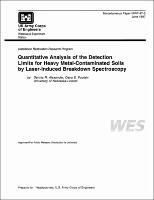Please use this identifier to cite or link to this item:
https://hdl.handle.net/11681/7768| Title: | Quantitative analysis of the detection limits for heavy metal-contaminated soils by laser-induced breakdown spectroscopy |
| Authors: | University of Nebraska--Lincoln Installation Restoration Research Program (U.S.) Alexander, Dennis R. Poulain, Dana Earl |
| Keywords: | Heavy metals Laser-induced breakdown spectroscopy LIBS Soil contamination Soil pollution Soil remediation Environmental aspects |
| Publisher: | Environmental Laboratory (U.S.) Engineer Research and Development Center (U.S.) |
| Description: | Miscellaneous Paper Abstract: Laser induced breakdwon spectroscopy (LIBS) is a rapid remote measurement method for detection of metals in the environment. A major factor in the quantitative use of this technique involves the minimum detection limits under both laboratory and and field operations. Research on limits of detection of heavy metals in different types of soils under various conditions using LIBS has been carried out under Contract DACA39-95-K-0053. Pulses from a Nd:YAG laser operating at 125 mJ at λ = 1.06 μm are focused on sample surfaces to produce laser sparks (plasmas). Atomic emissions from the plasmas are recorded using an optical multichannel analyzer after delays of a few microseconds when interference horn broadband emissions is reduced. Research has been performed on the detection limits of arsenic, cadmium, chromium, mercury, lead and zinc in soil matices. Results are reported on the lower detection limits of these six elements in sand, silt, clay, and kaolin matrices. Detection limits are significantly lower for heavy metals in sand matrices than silt and clay matrices due to differences between surface and volume contamination. |
| Rights: | Approved for public release; distribution is unlimited. |
| URI: | http://hdl.handle.net/11681/7768 |
| Appears in Collections: | Miscellaneous Paper |
